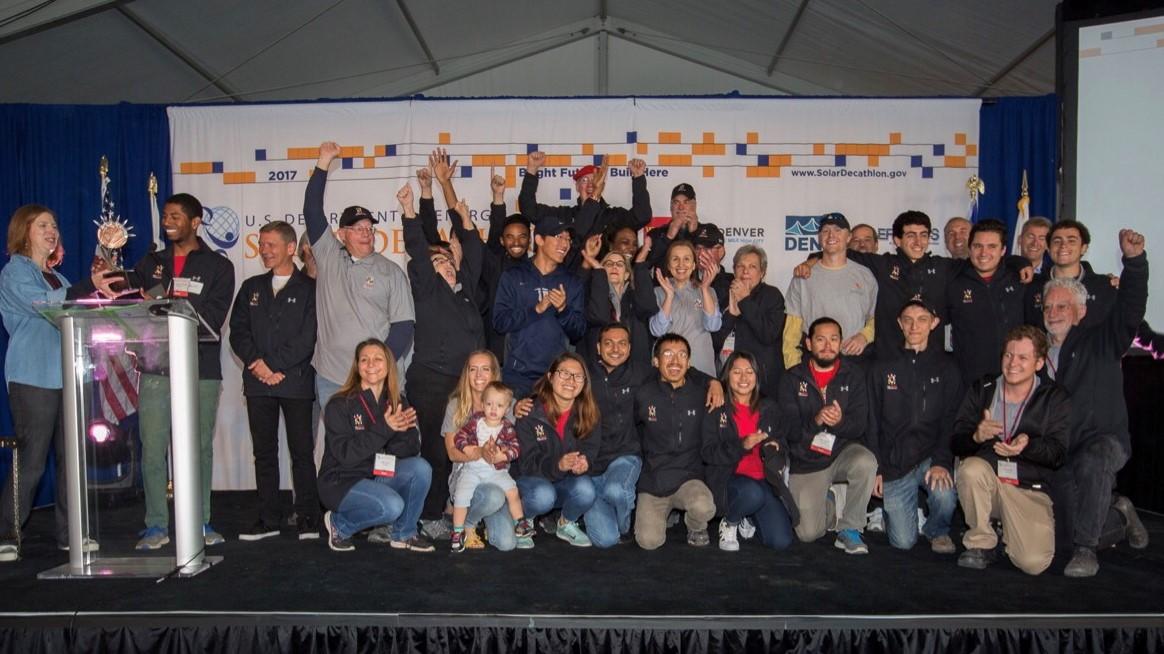A solar-powered house that blends Native American principles with cutting-edge technologies and modular design won second place at the U.S. Department of Energy Solar Decathlon 2017. Designed by an interdisciplinary team of students at the University of Maryland, the entry, called reACT, beat nine other teams from academic institutions around the globe, and was the number-one U.S. entry in this year’s competition. The teams competed in 10 cut-throat competitions over 9 days that evaluated each home’s performance, design, sustainability and market appeal. UMD’s winning team is a mix of students from architecture, engineering, plant sciences and several other disciplines campus-wide.
The Solar Decathlon is a biennial competition that challenges collegiate teams from around the world to design and build an energy-efficient, solar-powered house that is both affordable and attractive. The competition, which harnesses the collective knowledge of some of the brightest young minds in architecture, engineering, life sciences and technology, attracts thousands of visitors, including industry professionals, homeowners and designers from around the world. The two-year process—which spans from concept drawings to the construction of a physical house—culminates in a 10-contest competition lasting one week, this year in Denver, CO. This is the first year that teams are eligible for cash prizes; UMD will bring home $225,000.
Watch the winning team on WJLA-TV
Inspired by both technology and tradition, reACT connects the indigenous world with western scientific innovations to deliver a sustainable, regenerative, almost “living” model that intends to change the way the industry approaches housing. reACT is inspired by long-held principles of Native American cultures who, for centuries, have harvested the resources of the surrounding environment while minimizing waste and impact. With the addition of cutting-edge technologies, sustainable materials and an intuitive, modular design, Team Maryland devised a housing model that is completely solar-powered, water conservative, affordable and regenerative for diverse communities and ecosystems.
reACT goes beyond the solar-powered requirements of the Decathlon, capitalizing on the talents of UMD’s architecture, engineering and life science programs to devise several innovative features, including:
- Modular construction: its kit-of-parts allows for endless design schemes based on size, climate and budget. It also allows for low-cost, mass production that can be efficiently transported to the building site and assembled in the span of a week by local labor with relatively little specialized training.
- A mechanical core, which contains high-performance, interactive, environmentally sensitive automated system, coded by the students of Professor of Chemical and Biomolecular Engineering, Dr. Raymond Adomaitis. It manages the flow of water, air and energy, and directs architectural responses throughout the house, such as the Greencourt sky vents. All the other components—which can be customized to the needs of the family—clip onto this central core.
- A Greencourt, which is the team’s mating of a greenhouse and a courtyard, is the social heart of the house. Its flexible sliding doors and sky vents frame an open-air retreat in warm weather and insulated conservatory during winter months. Aside from acting as a social gathering space, the Greencourt is integral to the home’s resource capture. Solar energy generated by the Greencourt is harvested by the heat pumps of an innovative HVAC system developed by Research Professor of Engineering Dr. Yunho Hwang and students, then reused to warm the home and heat water. The rainwater gathered by the roof and downspouts is collected, filtered and reused in the house and garden.
- Gardens and food production are a big part of reACT. Outside, reACT utilizes a “three-sisters crop program” that indigenous tribes have been using for centuries, where the plants support each other as they grow reducing the need for watering and weeding, while providing habitat and creating food webs. Inside is an autonomous hydroponic garden, designed by Associate Professor of Architecture Dr. Hooman Koliji, for growing lettuce and herbs year-round.
- A solar attic that uses the energy captured from the sun to heat water, dry clothes, and even cook food. These specialized appliances are accessed through a Versalift elevator.
Read about the team’s win in the Washington Post
The state’s only Solar Decathlon entry, reACT is the University’s fifth entry in the history of the Solar Decathlon competition. UMD took first place in 2011’s competition with WaterShed, which harnessed the power of both sun and water. In 2007, UMD placed 2nd overall with its entry, LEAFHouse.
https://www.umdrightnow.umd.edu/news/umd-solar-decathlon-team-takes-firs...

